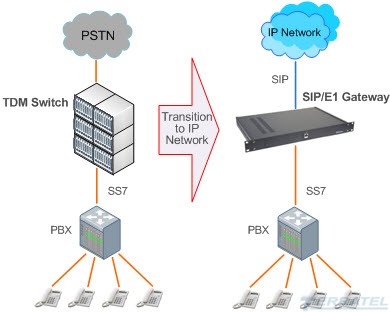Why we need SS7?
Signaling system №7 or as it is referred to as SS7, common channel signaling system, Signaling system 7 was designed to replace the existing signaling system, which worked on the information channels. These were the so-called inband signaling. It was created to exchange call control information between the digital switching stations, which support voice and non-voice services. Also common channel signaling №7 allows private customers and companies use a lot of additional features, for example, calls are charged to the subscriber who calls, caller ID, etc. CCS#7 is parallel to its own network, along with digital communication networks.
SS7 Signaling point
SS7 – is an individual network, so voice and data are transmitted one-way, all the signals it sends completely different. Before there was a network of SS7, telephone connection going through the same channels on which there was talk of subscribers. The fact that the user information and signals transmitted at different times. Has contrast SS7 ISDN. The latest network subscribers and switches can send each other signaling channel D, and here in the SS7 this exchange of information is possible only between network components. For general communication channels Class 3 devices: point signal (Signal Transfer Point, STP), the service switching point (Service Switching Point, SSP) and the service control point (Service Control Point, SCP). In general, these points are called nodes SS7 or SS7 signaling point.
As the start and end points used telephone switches SSP. They have software that is compatible with SS7. But for receiving signaling messages and routing them to the final destination, there are packet switches STP. STP packets consist of databases. They can provide the necessary information to process calls.
The network has a lot of redundant links that are between CCS7 nodes, allowing network is very reliable.
SIP and SS7 protocols
Signaling System number 7 (SS7) – a set of telephone signaling protocols that are used to create a switched telephone network. The main goal is to create phone calls. Other applications include translating numbers, local number, prepaid billing mechanisms, short message service (SMS), and many other services to the mass market.
This is usually referred to as the alarm or alarm system №7 # 7, or simply abbreviated as SS7. In North America, it is often referred to as CCSS7, an abbreviation for common channel Signaling System 7. In some European countries, including the UK, it is sometimes called C7 (CCITT number 7) and is also known as the number 7 and CCIS7 (Common Channel Interoffice Signaling 7). In Germany, it is often referred to as the N7 (Signalisierungssystem Nummer 7).
There is only one international protocol SS7, which is defined as the ITU-T in its Q.700-series recommendations. [1] There are, however, many national versions of the protocols SS7. Most national variants are based on two widespread national variants as standardized by ANSI and ETSI, which in turn is based on the international protocol as defined by ITU-T. Each national variant has its own unique characteristics. Some national variants with rather striking characteristics of China (PRC) and Japan (TTC) national variants.
Internet Engineering Task Force (IETF) is also determined by the level of 2, 3, 4 and protocols that are compatible with the SS7:
Message Transfer Part (MTP) Level 2 (M2UA and M2PA)
Messaging (MTP) Level 3 (M3UA)
Signaling Connection Control Part (SCCP) (SUA)
This set of protocols called SIGTRAN.
Session Initiation Protocol (SIP) allows telephone calls and similar sessions are to be made through the Internet, private data networks or cellular networks. This defines the messages sent between the parties (signaling) that govern the creation, termination and other necessary elements of the call (or, more generally, session, hence the name).
SIP is an IETF defined signaling and widely used for controlling communication sessions such as voice and video calls over Internet Protocol (IP). The protocol can be used for creating, modifying, and terminating two-party (unicast) or multiparty (multicast) sessions. Sessions may consist of one or several media streams such as voice or video data.
SIP is an application layer protocol designed to be independent of the underlying transport layer; it can operate in a Transmission Control Protocol (TCP), User Datagram Protocol (UDP), or Stream Transmission Control Protocol (SCTP). This text-based protocol, incorporating many elements of theHypertext File Transfer Protocol (HTTP) and Simple Mail Transfer Protocol (SMTP).
SIP to SS7
While as the main voice traffic between SIP and PSTN can transform a simple VoIP gateway is to provide high-quality communications, integration with mobile network requires integration with SS7.
Company Terratel provides SS7 to SIP gateway, which is able to convert a SIP SS7 or SS7 to SIP in order to control and media, and data components of the call.
Terratel offers the perfect solution with a cost-effective SS7 to SIP gateway. This solution is based on SIP E1 Gateway enables communication between SIP and SS7 in one or more points of presence.
Apparatus Terratel SIP / E1 Gateway can be applied with two options:
1. You need to replace TDM Switch on Soft Switch (SS7 to SIP). In a situation where a TDM switch connected to many subscriber outlets interface SS7, then using the Gateway Terratel SIP / E1 can be switched to the Soft Switch.

To translate SS7 in SIR from TDM gateway interface is disabled V5.2, and at the same time connected to the gateway Terratel SIP / E1 Gateway. A gateway, in turn, is connected to SoftSwitch via a data network over SIP protocol.
2. It is necessary to switch VoIP subscribers on a local network numbering PSTN. Thus, the transformation occurs SIP to SS7 Gateway (SIP to SS7). If the operator is already free from TDM switch interfaces SS7, then he gets a gateway SIP / SS7 as an outstation toward TDM, and a IP-PBX to IP network. On the same IP-PBX IP-subscribers are registered.

To learn more about SS7/SIP Gateway go to link https://www.terratel.eu/sip-e1-gateway.html
